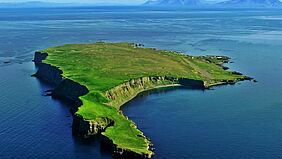Under SMARTrenew, residents of Grímsey island—the only part of Iceland to cross the Arctic Circle—are currently investigating how best to reduce their reliance on burning fossil fuels for electricity generation. The island is not connected to the national grid.
Energy-saving lightbulbs were a simple first step and now the islanders are considering installing wind turbines and solar panels.
Grímsey has until now relied on diesel for its electricity and its heat, as there is no geothermal hot water on the island, 40 kilometres north of the mainland. The generators are operated by Rarik, the public-owned energy company that focuses on remote and rural areas, and the cost is heavily subsidised by the State. The generators are due for renewal this autumn—an expensive operation that only adds to the already-high cost of burning 250,000-300,000 litres of diesel a year. Energy saving is in everybody’s interest.
“We have been experimenting with biodiesel use; biodiesel that is produced by Orkey in Akureyri. That has made a major difference. We have reduced our fossil fuel use significantly in this way. But now we want to look to the next steps that will be orientated towards an energy shift and add wind energy and maybe solar energy here and there,” says Sigurður Friðleifsson, the director of Orkusetur, energy centre and SMARTrenew partner.
He says that every small step towards energy efficiency on Grímsey is important. LED lightbulbs in homes and streetlights, for example, have already had a positive impact. He adds that the island is ideal territory for wind turbines.
“Yes, they are attractive. This is a small community and a small system so the biggest and most economical turbines would not work there, but smaller ones that would be backed up by the diesel generator would work well there,” says Sigurður.
Energy change on Grímsey has garnered a lot of attention on and off the island—including at the American embassy.
“That discussion mostly stemmed from the fact that they have certain experience working with small, isolated communities that run their own energy generation, which until now has mostly been diesel. They want to try and find ways to add wind and solar energy into the mix to reduce diesel use,” Sigurður says.

